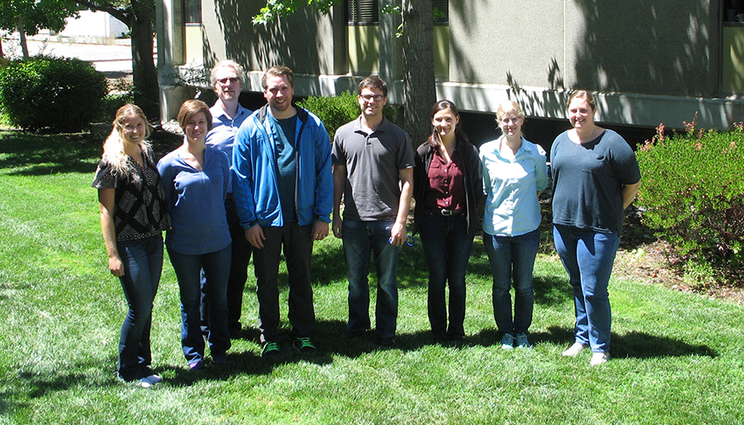Nuclear forensics program aims for critical mass
 (Download Image)
Mavrik Zavarin (third from left), director of Lawrence Livermore National Laboratory’s Glenn T. Seaborg Institute, with students from the 2016 Nuclear Forensics Summer Program.
(Download Image)
Mavrik Zavarin (third from left), director of Lawrence Livermore National Laboratory’s Glenn T. Seaborg Institute, with students from the 2016 Nuclear Forensics Summer Program.
A sure sign of summer is the return of interns to the Lawrence Livermore campus. Students interact with premier researchers and access equipment and facilities not available anywhere else, while scientists lay groundwork for advancing their fields. Within the Physical and Life Sciences directorate, the Glenn T. Seaborg Institute runs an eight-week summer internship for students interested in nuclear science and its range of specialties — nuclear forensics, environmental radiochemistry, nuclear physics and beyond. Together these disciplines support the Laboratory’s nuclear security mission through analysis of nuclear processes and properties.
Founded in 1999 as the Actinide Sciences Summer Program, LLNL’s Nuclear Forensics Summer Program is currently funded by the National Technical Nuclear Forensics Center within the Department of Homeland Security’s (DHS) Domestic Nuclear Detection Office. Seaborg Institute Director Mavrik Zavarin oversees the program and the 2016 class of 13 students. The summer program aims to train the next generation of nuclear scientists and engineers in areas critical to DHS and the National Nuclear Security Administration.
The 2016 class includes Katie Hoffman, a fourth-year Ph.D. student at the University of Cincinnati. Her Ph.D. adviser previously sent two students to the summer program and encouraged her to apply. This was Hoffman’s second year at LLNL, and the experience of working alongside the same mentor on the same project for consecutive summers helped shape her dissertation on radioanalytical chemistry.
Livermore connections also compelled Austin Carter to pursue the summer program. This fall he begins graduate study in nuclear engineering at the University of Michigan. Last summer he interned in LLNL’s Global Security directorate, where he met radiochemist Narek Gharibyan, who ended up mentoring Carter in the 2016 summer program.
The Real Deal
The Seaborg Institute’s summer program offers more than experience for its own sake. As Zavarin explains, "It’s a unique opportunity. Students team up with a principal investigator doing research with national security implications."
Hoffman assisted researcher Ruth Kips in testing soil samples from the Marshall Islands, a site of Cold War nuclear testing. Their research explores how soil absorbs the cesium-137 isotope, giving scientists insight into how radioactive elements move through contaminated material. With real-world impacts to radioactive environments, Hoffman acknowledges the summer program’s high expectations: "There’s pressure to do it right."
Carter worked with Gharibyan and nuclear engineer Lucile Dauffy on Monte Carlo code modeling, which allows researchers to understand the post-shot neutron environment inside the National Ignition Facility. In support of post-detonation nuclear forensic research, Carter’s code simulated the dispersal of neutrons in the target chamber, which contains different diagnostic instruments and experimental platforms. "The more you compute," Carter reasons of the workload, "the more accurate you can get."
Valuable Opportunities
In addition to collaborating on projects and attending a seminar series, the program’s students participate in LLNL’s Student Poster Symposium. Emphasizing the program’s intensity, Hoffman says, "Eight weeks pushes you to make the most of it." Carter is impressed with scientists’ willingness to include students in their work, and notes that prospective interns should not be afraid to approach mentors with questions. Hoffman agrees: Mentors listen to students’ opinions and provide ample training while also granting interns independence. "I feel valued," she says.
For both of these students, exposure to LLNL’s scientists and facilities is a one-of-a-kind opportunity. Hoffman used the Laboratory’s scanning electron microscope and NanoSIMS (nanoscale high-resolution secondary ion mass spectrometer), while Carter received an in-depth tour of the National Ignition Facility’s target chamber. Zavarin enjoys seeing students develop as researchers and learn how to communicate with, as he calls it, "the language of science."
Beyond specific projects, mentors are glad to guide interns. For Gharibyan, mentoring offers two-way benefits: "It gives me an opportunity to think about my work from a more fundamental perspective," he explains, while students gain hands-on experience at a national laboratory.
Paying It Forward
Summer projects can influence students’ graduate work beyond Livermore. For example, Hoffman plans to evaluate soil samples at her university and apply LLNL-learned experiments to other isotopes. Carter wants to extend his Monte Carlo knowledge to simulate radiation transport within nuclear reactors and safeguards.
Gharibyan enjoys helping students kick off their careers and hopes interns continue passing knowledge to the next generation, just as he has done — Gharibyan interned at Los Alamos National Laboratory’s Seaborg Institute before completing his PhD. For students considering the summer program, Hoffman advises, "Come prepared to give input and work hard."
Many former interns have returned to LLNL as postdoctoral researchers and employees. Some students receive Laboratory-funded scholarships, while others network with mentors for professional opportunities. As Zavarin summarizes, "We take the long view with students’ development."
Given the small community of nuclear science and its importance to the Laboratory, Zavarin emphasizes the need for growth. He and his colleagues strengthen the workforce pipeline by promoting the Seaborg Institute and the summer program at national meetings and invited talks, and through education partnerships with Washington State University, the Colorado School of Mines and the Nuclear Science and Security Consortium at the University of California, Berkeley. The Seaborg Institute also hosts San Jose State University’s National Nuclear Chemistry Summer School students for a day at the Laboratory. "Our summer program is one piece of a bigger puzzle," says Zavarin. "The network of programs is providing a critical mass of young nuclear scientists for the nation."
―Holly Auten
Contact
 Anne M. Stark
Anne M. Stark
[email protected]
(925) 422-9799
Related Links
Nuclear Forensics Summer ProgramNational Technical Nuclear Forensics Center
Physical and Life Sciences directorate at LLNL
Glenn T. Seaborg Institute
Tags
Physical and Life SciencesCommunity Outreach
Featured Articles







